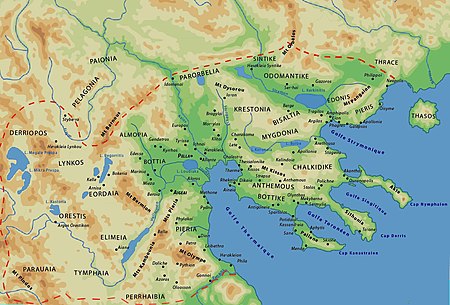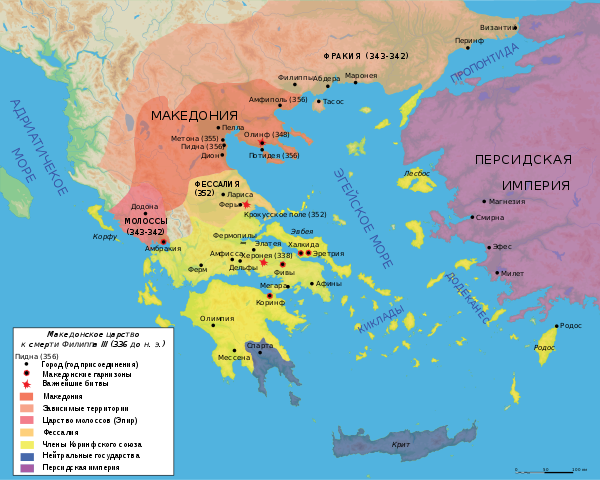Macedonia
Macedonia (Greek: Μακεδονία) is an ancient Greek state on the Balkan Peninsula with its capital in Aegae, and then in Pella, bordered by the state of Epirus to the west, Thrace to the east, and Thessaly to the south.
In the prehistoric period, Macedonia was a territory through which carriers of Neolithic cultures penetrated into Europe from Asia Minor (see Prehistoric Greece for more details). At the end of the Bronze Age, various Indo-European tribes invaded Macedonia from the north, some of which went further into Asia Minor, while others moved into Greece.
The word "Macedonia" comes from the Greek μακεδνός, meaning "high".
The first Macedonian state was founded in the 8th century BC or early 7th century BC by the Greek Argead dynasty - immigrants from the southern Greek city of Argos (hence the name - Argeads), who traced their origin to Hercules. The first king of Macedonia was Perdiccas I (according to later data - Caranus).
 Territory of the Macedonian State
Territory of the Macedonian State
Early Kingdom
The mythical founder of the Macedonian state was named Caranus, identified with the son of the Argive king Temenus, Archelaus. According to Justin, from Caranus to the last king of Macedonia, Perseus, 924 years have passed, which dates the reign of Caranus to the 11th century BC.
According to Herodotus and Thucydides, the founder of the reigning dynasty is considered to be Perdiccas I, a native of Argos, located in the eastern part of the Peloponnese. According to Macedonian legends, he fled to Macedonia with two brothers and first hired himself as a shepherd-goatherd. According to the testimony of ancient historians, Macedonian tribes living in the basin of the Haliacmon River (Greek: Αλιάκμων or Αλιάκμονας) and adjacent plateaus, in the 8th century BC, began their movement to the east to the Aegean Sea and to the north to the Strymon River (Στρυμών or Στρυμόνας), displacing, exterminating or assimilating local tribes of Illyrian, Thracian, and Phrygian origin.
Inheriting, as it was believed, the lands of the mythical kingdom of Midas, Macedonia, led by the Argead dynasty, formed into an independent state under King Alexander I in the early 5th century BC. It was under him that they began to mint royal coins, under him Macedonia, which had been isolated for a long time, came into contact with Hellas, and under him the country's territory significantly expanded. Until Alexander I, Macedonia was inhabited by various tribes that had their own leaders, and Macedonian kings ruled only nominally in the Central Macedonia region.
In the early 5th century BC, Macedonia and the lands adjacent to it were conquered by the commander Mardonius, sent by the Persian King Darius I to conquer Greece. The Persians helped the Macedonian king to strengthen and expand his power (see Achaemenid Macedonia). After the Persians were defeated, the expansion of the Macedonian state continued, and Alexander's successor, Perdiccas II, felt strong enough to wage war against Athens (420s BC). During the Peloponnesian War, Perdiccas II used Spartan troops to suppress the separatism of the mountain tribes.
In the time of Amyntas, Macedonia was a backward barbarian country surrounded by barbarian peoples, without large cities and definite borders, where no Greek dared to penetrate, and the Persians did not even want to send troops to conquer the poor inaccessible terrain.
Perdiccas' successor, Archelaus, built fortresses, laid roads, and created a regular army. Under him, the cultural influence of Hellas in Macedonia significantly increased, the famous Euripides lived at the king's court and even held an official position. At the end of the 5th century BC, Macedonia establishes power in the adjacent Greek cities, Pidna and Larissa. The borders of the Macedonian kingdom lie approximately along the Haliacmon river in the south, separating Macedonia and Thessaly (a region of Hellas), the Aegean Sea, and to the Strymon river in the east, separating it from Thrace. The Pindus ridge in the west separates Macedonia from Epirus and Illyria, and the upper course of the Axios (Vardar or Axios in modern Greece) serves as the border in the north.
Soon after the murder of Archelaus (399 BC), due to unfavorable external factors and internal turmoil, the Macedonian kingdom weakened. Kings as a result of the fierce struggle for the throne were replaced quickly. By the middle of the 4th century BC, the country was on the verge of collapse.
Later Kingdom
In the first half of the 4th century BC, the country was torn apart by civil strife, and there was a real threat of the country being taken over by Thracian and Illyrian tribes. It was the external threat that allowed Philip II to concentrate the armed forces, repel the external onslaught and force the Macedonian clans to submit. Philip's far-sighted, strategically accurate policy strengthened the state and predetermined the expansion of the Macedonian kingdom into the territory of Hellas, which by that time was weakened by endless disputes.
Under King Philip II (359—336 BC), the territory of Macedonia expanded and included the gold-rich Pangea, Chalkidiki, all Greek city-states on the Thracian coast of the Aegean Sea, the lands of the Thracians in the east, the Illyrians in the west, and the Paeonians in the north. Epirus and Thessaly became vassal states of Macedonia. After the battle of Chaeronea, all of mainland Hellas, except Sparta, acknowledged its dependence on the Macedonian king. In their attitude towards Philip II, the Greeks were split: some (Demosthenes) viewed him as an aggressor, the strangler of the freedom of Hellas, while others (Isocrates) welcomed him as a leader capable of uniting fragmented Hellas.
During this period, Macedonia was heavily influenced by ancient Greek states, while maintaining its ancient distinctiveness. For example, the architecture of the palaces in Pella is closer to the Cretan-Mycenaean style than the classical, although it should be noted that due to the political system, the Hellenes preferred to build temples instead of palaces. Family life was also different; polygamy was allowed, and besides Olympias, the mother of Alexander, Philip II had several other wives, although they all had different statuses. The Macedonians of that era seemed crude and ignorant to the refined Greeks, with manners similar to those of the barbarians. The religion of the Macedonians, although influenced by Thracian traditions, was not different from the religion of the rest of the Greeks. The Macedonians worshiped the gods of Olympus. After preparing for a campaign to the lands of Persia, Philip II did not have time to carry out his plans. He was assassinated, like previous Macedonian kings, but left behind a strong regular army and a strong state.
Philip's son, Alexander the Great (356—323 BC) managed to expand the borders of the Macedonian kingdom during his reign, incorporating not only the Greek city-states, but also the entire Persian Empire, Ancient Egypt and part of India, thereby creating an empire. However, it is hardly appropriate to call Alexander's cosmopolitan empire a Macedonian kingdom, because after the conqueror's death it did not last long, divided between his generals - the Diadochi. Macedonia and Greece were taken over by one of the generals named Antigonus I Monophthalmus, who founded the Antigonid dynasty. The Seleucid state included the largest part of the empire.
Alexander actively used the cultural heritage of the conquered states, but at the same time introduced the conquered peoples to Greek culture and encouraged the study of Greek sciences. Although the newly formed empire fell apart soon after Alexander's death, its legacy persisted and allowed the conquered peoples to enter the Hellenistic era. The population of Hellenistic countries in Asia even in the 2nd century AD constituted more than a quarter of the Earth's population. Greek Koine was the language of international communication for most countries in the world for more than a millennium.
In 330 BC, Alexander the Great's general Zopyrion undertook a campaign to Scythia, which resulted in his thirty thousand-strong army being defeated.
 Kingdom of Macedon and its dependencies in 336 BC
Kingdom of Macedon and its dependencies in 336 BC
Macedonian decline
Pyrrhus, king of Macedonia and Epirus, defeated the Romans in 279 BC, but did not gain fame. The relative small number of Macedonians could not withstand the onslaught of the Roman Republic, and Perseus of Macedon did not put up the expected resistance to the invaders. The way to conquer Achaia was open.
In 215 BC, Macedonia entered the first of three wars against Rome: the result of the lost second (197 BC) and third (168 BC) was the overthrow of the ruling dynasty. When Macedonia was conquered by the Roman Republic, the country was divided into four independent republics with an aristocracy at the helm, which paid tribute to Rome. In 149 BC, a certain impostor named Andriscus appeared in Macedonia, claiming to be the deceased son of Perseus, Philip VI. This led to the fourth Macedonian war. In 148 BC, the Romans defeated the false Philip. The result was the declaration of Macedonia as a Roman province in 146 BC.
Related topics
Ancient Greece, Philip II, Alexander the Great
Literature
- Mark Junian Justin. Epitome of Pompey Trogus ' Philippian History
- Hammond N.-J.-L. Illyria, Epirus and Macedonia. - In: Cambridge History of the Ancient World, vol. 3, part 3: Expansion of the Greek World. (chapter on early Macedonia and related regions) - Moscow: Ladomir, 2007. - ISBN 978-5-86218-467-9
- Shofman A. S. Istoriya antichnoi Makedonii [History of Ancient Macedonia]. In 2 parts. Kazan: Kazan University Publishing House, 1960-1963.
- Kuzmin Yu. N. Vnutrennaya i vneshnaya politika Makedonskogo tsardva (270-230-e gody B.C.): Avt. diss ... Candidate of Historical Sciences-Saratov, 2003.
- Burov A. S. Voennye sily i voennaya politika Makedonii (70-20-e gg. III veka B.C.): Avt. diss ... Candidate of Historical Sciences-Moscow, 1996.
- A. B. Ranovich. Hellenism and its historical role, Moscow: Publishing House of the USSR Academy of Sciences, 1950, 264 p.
- Talakh V. N. Whatever King Demetri wishes / Edited by V. N. Talakh and S. A. Kuprienko, Vidavets, S. A. Kuprienko, 2013, 229 p. ISBN 978-617-7085-01-9.
- Selian E. The Mystery of the Name «Macedon». American Chronicle, June 2009


